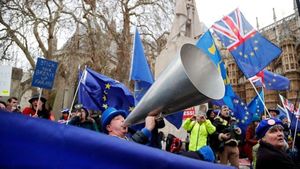On January 27, 2025, the Trump administration made headlines with its controversial announcement to pause federal loans and grants, triggering panic and confusion among countless recipients who rely on these funds. The shocking directive affected around 2,600 federal programs, aimed at aiding sectors from education to clean energy, reflecting alarming ramifications for millions of Americans.
Just two days after the announcement, the chaos led to legal action. A federal judge intervened on January 29, temporarily suspending the freeze until February 3, following urgent lawsuits from a coalition of nonprofits and 22 Democratic-led states. These groups quickly pointed out the potential devastation this funding freeze could impose, particularly on the estimated 9.9 million students who depend on federal financial aid for their college education.
"This harmful decision, pulled from the Project 2025 playbook, would rob Americans of trillions of federal funding dollars," stated The Independent, capturing the frustration of those on the receiving end of such federal assistance. The administration's halt on federal spending left advocacy groups scrambling to decipher the memo and its long-term repercussions.
The White House attempted to clarify its stance within hours of the freeze announcement, assuring the public through Department of Education spokesperson Madi Biedermann. "No program providing direct benefits to Americans is explicitly excluded from the pause," she said, emphasizing key programs such as Pell Grants and federal student loans would remain unaffected by the directive.
The confusion stemmed from the initial memo, which, as reported by The Washington Post, outlined various categories of funding on hold, focusing heavily on financial assistance for minorities, organizations promoting diversity and equity, and various clean energy initiatives. Lawmakers, including Senate Minority Leader Chuck Schumer, quickly voiced their concerns, calling for immediate reversal of the funding pause. "We know they will come back at this again and again and again," Schumer declared, highlighting the political ramifications surrounding Trump’s controversial funding strategy.
Despite quickly rescinding the funding freeze on January 29, the White House made it clear the broader effort to curb certain federal funds would persist. The resulting legal battles only served to heighten anxieties about what additional measures the administration might pursue. Leavitt stated on social media, "This is NOT a rescission of the federal funding freeze. It is simply to end any confusion created by the court's injunction. The President's executive orders on federal funding will be rigorously implemented."
Legal experts have noted the precarious nature of this directive, with many arguing it potentially violates the Appropriations Clause of the U.S. Constitution, which strictly assigns the power of the purse to Congress, not the president. Further complicity arises from the U.S. Impoundment Control Act of 1974, which restricts presidential authority from withholding funds. Such foundational checks on funding dictate the balance of power vested within federal frameworks.
The effects of this funding freeze could ripple across various sectors. Trump’s actions jeopardize not only educational funding but also housing assistance programs and clean energy initiatives passed under recent legislation like the Inflation Reduction Act. Several key programs necessary for supporting low-income families and minority communities are also threatened. For example, initiatives like the Low-Income Home Energy Assistance Program (LIHEAP), which helps families stay warm during the winter, could face severe cuts, leaving millions vulnerable to the elements.
Many experts worry about how prolonged disruption could dismantle the very support systems on which vulnerable populations depend. Amid continued uncertainty, environmental justice organizations are expressing alarm over potential reductions to grants aimed at climate action initiatives. Nonprofits reliant on federal funding have already reported being blocked from accessing necessary resources, illustrating the far-reaching consequences of the administration’s funding freeze.
The chaos resulting from the Trump administration's funding directive is not merely bureaucratic; it reflects underlying loyalties favoring wealthy allies over the general public. The abrupt halt has also led to sudden job losses within federal programs, exacerbated by the turbulent job market.
Both private and public sector advocates are launching campaigns urging Congress to intervene and protect funding meant for communities and programs deemed non-controversial. With lawmakers eager to protect their constituents, many are pushing back against the administration's priorities exhibited through this funding freeze.
Trump's path moving forward remains fraught with legal challenges and entrenched opposition. So far, states and organizations continue to navigate the convoluted maze erected by the administration, fully aware their battle may shape the future of federal financial assistance.
With the ruling expected from the federal judge on February 3, the ramifications of the Trump administration’s funding freeze could become more apparent. This will force stakeholders from students to state officials to strategize their next moves based on the court's decision. Sustained advocacy for equitable federal funding remains imperative—amid uncertainty, Americans need their government to deliver basic services reliably. The stakes are high, and the battle lines have been drawn between supporting everyday people with necessary federal aid and the administration’s controversial directives.



